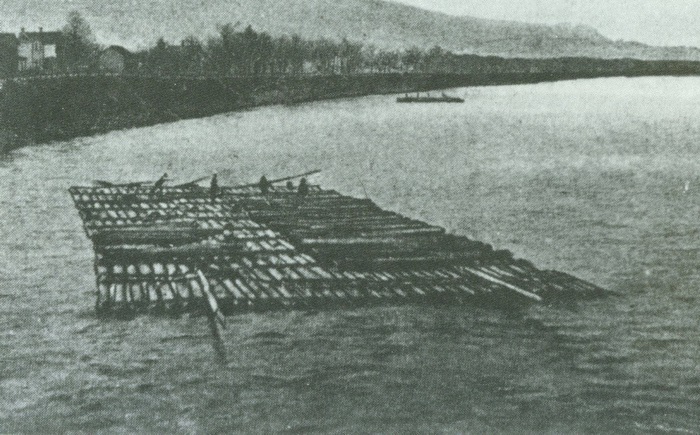Joel Kimball Diary - April 1874
![]()
Wednesday, April 1, 1874
"Went on the hill with steers and drew out some rails, wood and logs. Drew
load of wood home. After noon went on the hill and cut wood."
Joel Kimball
When ideal conditions existed at a "sugar bush" the making of maple syrup
became a hectic, full-time endeavor. Each spile location needed to be
visited often and regularly, the troughs beneath constantly drained and the
sap gathered hauled to a central collection trough. Here, the sap was boiled
within a large pan, the fire underneath needing continuous attention until
the sap was finished off to syrup. - Fred
"Went on the hill with axe and pail. Sap did not run so I made troughs, cut some wood and tapped some trees.
"Weather cool and cloudy. Sap ran in the afternoon. In evening called at John M. Sheeley's and got sap yoke."
Joel Kimball
"Yoke n, [ME yok fr, OE geo; akin to OHG joh yok, L jugum, Gk zygon, L jungene, to join]
"...c: a frame fitted to a person's shoulders to carry a load of equal portions."
Webster's Seventh New Collegiate Dictionary - Fred
"Boiled sap all day. Grandfather came in the woods and brought my dinner. Sap ran pretty good, cut some wood.
"Weather warm and windy."
Joel Kimball
The boiling off of sap to maple syrup required being vigilant at just the right
moment. Today, enclosed evaporators, the heat fueled by gas and the sap
temperature monitored by gauges, lets the boilermaker know at the precise moment when the finished product is ready. This was not the case in 1874.
When boiling sap, the critical temperature to reach is 216 degrees, beyond which the liquid becomes crystallized. Without a temperature gauge, Joel needed to know when this critical moment was on hand. Constantly stirring the boiling sap, so as not to burn the liquid on any hot spot within the pan, Joel would continuously lift the ladle from the brew and watch the liquid drip back into the pan. At the critical moment, the dripping would shed off the ladle as if it were a sheet of wax. This "waxing" indicated that the brew boiling in the pan was now syrup. - fred
"Drew a load of wood off the hill and cut some. Wm. P. Rose cut brush near fence line on the hill. After noon, I worked at deer skins, cut wood and went to the post office. Received a letter from L.D. with photo, also papers from Liberty.
"Weather very cold and windy, freezing in the afternoon.
"Traded axe halves with J.M. Sheeley for piece of steel."
Joel Kimball
William P. Rose, Joel's neighbor, was originally a tenant of the land that he
now owned in 1874, purchasing the fifty acre farm in 1859 from Benjamin P
Buckley, who like Cyrus Gray of Parksville and Joseph Young of Liberty, owned numerous virgin-timber lots along the Willowemoc valley. The Buckley family were amongst the earliest of settlers in the town of Liberty, Luther Buckley moving his family from Connecticut in 1807 and is credited with opening the first general store within that township. A shoemaker by trade, he was also credited with building the gristmill at Liberty Falls and more notably establishing the first hotel in that community known as the Buckley House.
Luther's grandson, Benjamin P., who was involved with the family business,
became supervisor of that township for two different terms between the years of 1847 to 1851. While in this position, he was appointed onto a panel to
investigate the possibility for the division of the township of Callicoon.
Though Buckley opposed the measure, he was in the minority and the division of the town was approved in 1851, creating the Town of Fremont. Ironically,
Benjamin P Buckley would soon move to that township.... - fred
"Pleasant morning, not so cold as it was yesterday. Went with John Decker and B. VanGaasbeck and got some wintergreens. Saw some succors in the river.
"Wrote to L.T. and called to Uncle Billing's in the afternoon. Sid called in the
afternoon while I was gone."
Joel Kimball
Benjamin P. Buckley's move to the Town of Fremont quickly resulted with the
erection of a tannery in the wilderness community of Fremont Center. With the success of this enterprise, the community thrived and Buckley, now the head of the firm of Buckley & Son, added a mercantile business and service shops. He and his family soon rose in prominence within the township of his new residence, being elected town supervisor in 1865 while his son, Frank, was elected to the same position a short time later. - fred
"Worked at axe halve in forenoon and filed for mortgage for Thos Dolan. Drew
load of wood. Uncle Ed called. Cut and drew wood in the afternoon."
Joel Kimball
This past year, Sullivan County has made much to-do about the coming celebration for its two-hundredth year anniversary. The front page of the local newspaper, and subsequent pages, are filled with photographs of local, prominent dignitaries celebrating the event with other local, prominent dignitaries, all seemingly congratulating themselves for presiding over this accomplishment. Local scribes for the newspaper, more attuned with stories covering school board meetings or recent penny socials, have now become writers of history, with error-prone articles. Here in Rockland, the turn-of-the-last-century postcard of Koon Brothers' mill at Emmonsville, which was published in a recent collector's edition of the local tabloid, was mislabeled "Roon" [with an R] and the view of the "factory", which was a lumber and turning mill, misrepresented as a tannery, mistakes that are now forever noted as historical fact for future researchers.
Benjamin Buckley's accomplishment was likewise ignored in error. Within the same publication, a list of county "history makers" includes William Curtis, from Callicoon Depot within the Town of Delaware, who was said to be the only person to serve two different townships in the county as supervisor. This, though, does not seem to be the case as the earlier biography of Benjamin Buckley points out. In fact, Buckley's feat is more impressive. Curtis became supervisor from two different townships by not even changing his residence, as the town in which he resided was divided from the larger township of Cochecton, while Buckley changed his residence from Liberty, soon after being the supervisor there, and quickly gained the trust and respect from his new neighbors at Fremont, allowing him to represent them as supervisor. - fred
"Went to B. Smith Shop and got wedge, made spiles, some rails and sent letter to Tillie. Boiled sap in the afternoon and gathered some and put in stone trough."
Joel Kimball
When making maple syrup, Joel utilized what natural resources that were
available. Earlier, he made troughs which were used to collect the sap as it
dripped from the tree. Blocks of wood, most likely of maple, were sawed in half, hollowed out to form a container and placed at the base of the tree, which most likely were tapped with numerous spiles. The contents of these wooden troughs were then collected during a "run" and the sap stored within a larger trough, this one of a hollowed piece of stone. Here, the physical qualities of the stone would allow the sap to remain relatively cool, so as not to spoil until Joel could gather enough sap in which to conduct the next burn. - fred
Wednesday, April 8, 1874
"Went over to the Beaverkill and caught succors with net,
got 1,000. Ate dinner at O. Sprague's, had a very good time. Saw Dave and
Julia on G.D. Kimball place, grandfather and Uncle Billings went along.
"Rained all day."
Joel Kimball
![]()
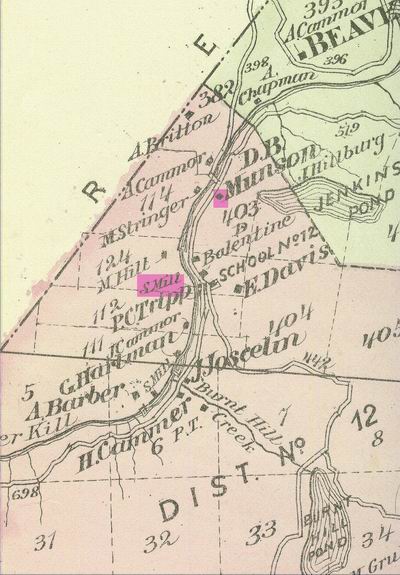 Joel's
newlywed sister, Julia, and her husband, Dave Munson, recently moved onto
the old George Kimball farm along the Beaverkill. George Kimball, an uncle
to Joel and Julia, was an early lumberman and rafts man along the upper
Beaverkill valley. In 1843, he and his brother-in-law erected a sawmill
alongside the river on his place, becoming a large lumber bank and the
starting-out point for colts of Beaverkill lumber.
Joel's
newlywed sister, Julia, and her husband, Dave Munson, recently moved onto
the old George Kimball farm along the Beaverkill. George Kimball, an uncle
to Joel and Julia, was an early lumberman and rafts man along the upper
Beaverkill valley. In 1843, he and his brother-in-law erected a sawmill
alongside the river on his place, becoming a large lumber bank and the
starting-out point for colts of Beaverkill lumber.
The upper Beaverkill's river channel is narrow and
winding, making steering of cumbersome small rafts particularly dangerous
in this section. Philip Weyrauch, who had a farm on the back side of
Shandelee Lake, worked out at the Kimball mill, piloting rafts down the
river in the spring. On March 11th, 1871, he set out with a colt formed on
the Kimball bank. The river was high and the current fast, with water
swollen by the cold snowmelt draining from the surrounding hills.Once in
the swift current, Weyrauch immediately ran into trouble and the raft
broke-up, throwing him into the frigid waters and sent downstream by the
current. He was not found until days later as the river's height receded,
the body caught amongst the riverside debris below Cooks Falls, over
ten miles distant downstream. - Fred
"Boiled sap all day, gathered about 60 pails.
"Weather warm and cloudy."
Joel Kimball
![]()
George Kimball was the thirteenth of the fourteen children of Levi and
Abigail Kimball, the earliest settlers at Westfield Flat. George married
Elizabeth Hitt in 1816 and they themselves had twelve children. All twelve
survived well into adulthood, an unusual feat during this era for such a
large family. All were born Kimball's Beaverkill farm and all of the
daughters, of which there were nine, were married on the same farm.
The youngest of the girls, Hannah, married Hiram Borden. A veteran of the
Civil War, Hiram had enlisted with the 143rd New York Regiment at Liberty
during the organization of this local unit. Even though General Lee had
surrendered his Confederate Army on April 9th, 1865 at Appomattox
Courthouse, the Union Army commanded by General Sherman still campaigned
through North Carolina. Hiram was captured by the opposing Rebel army on
April 12th, but soon hostilities ceased and was paroled along with the final
truce between the opposing armies.
Taking advantage of the government land program offered to veterans, Hiram
and Hannah eventually moved from the Town of Rockland to the then wilderness
forests of Michigan. Hiram was the brother of Oliver Borden, the shoemaker,
who was in turn married to Catherine Hodge, Joel's mother's sister. - fred
"Snowed nearly all night, snow about three inches deep, continued to snow until nearly noon. Gramdfather called and he and I made whip lashes. After noon Wm. P. Rose and I drew wood off the hill."
Joel Kimball
![]()
Elizabeth Hitt Kimball, wife of George D. Kimball, died in December of
1855 at the age of 58, leaving her husband to care for the two youngest
children, Levi and Hannah, on their Beaverkill farm. According to the
Kimball family historian, George remarried in 1859, to Eunice Appley at Linn
County, Iowa. How he came to be on the prairie is unknown but he soon was to
return to the hills and forests of Rockland; the 1860 census place him, his
new wife and his youngest son, Levi, back on the farm along the Beaverkill
River.
The distant drumbeat of war stirred excitement into the young Kimball boy,
along with other young men from Sullivan County. The War of the Rebellion
had yet to have any serious confrontations when the first call for
volunteers in Sullivan County was made in May of 1861. John Waller, the
publisher of a Monticello newspaper, recruited 94 of the local boys,
including Levi Kimball and Seth Allen Rose [more on Rose at a later date],
and by the end of the month, this recruitment reported to Albany to become
Company H of the 28th New York Volunteers. - fred
"Went up to Uncle Billings' with Bish and got Ned and fished for succors until noon near J.E. Spragues. Caught about 200. Rained and snowed some.
"After noon went on the hill and boiled sap. Snowed and rained until about 6 o'clock then wind blew and grew cold."
Joel Kimball
![]()
Early spring brought freshwater fish migrating up the rivers and their tributaries to spawn. Suckers, not particularly noted as either a game or food fish, would gather in large numbers at pools and eddies during this seasonal ritual. Though small scoop-nets were sometimes used to capture these fish, the more popular sport was that of spearing. Blacksmiths would sharpen and reconfigure old horse-shoes into a fork, which was then attached onto a pole. Standing either along the shoreline or wading within the pool, the challenge was to thrust the spear into the water and impale its target. - fred
Sunday, April 12, 1874
"Cold windy morning. Done chores and went up to Col. Moore's about 10
o'clock and came home about 6 o'clock and read New York Ledger.
"Very clear day, no clouds all day."
Joel Kimball
![]()
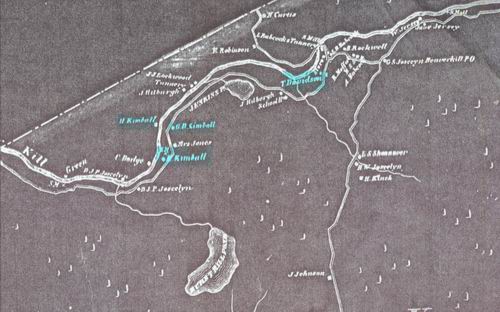 Immediately after the Civil war, the sons of George Kimball left the
Beaverkill valley. Henry, forty-three years of age and with a family of
five children, had the farm across the river from his father's place. The
family pulled-up stakes in 1865 and moved back to the prairies of Linn
County, Iowa. Tragedy soon struck, though, for Henry's wife died soon
after the move. He remarried in 1872, to Emma who was nineteen years
younger than he, and together began his second family.
Immediately after the Civil war, the sons of George Kimball left the
Beaverkill valley. Henry, forty-three years of age and with a family of
five children, had the farm across the river from his father's place. The
family pulled-up stakes in 1865 and moved back to the prairies of Linn
County, Iowa. Tragedy soon struck, though, for Henry's wife died soon
after the move. He remarried in 1872, to Emma who was nineteen years
younger than he, and together began his second family.
Levi also moved to Iowa, to the Mississippi River town of McGregor.
Here he married, eventually continuing his westward migration to the high
plains of Nebraska where he lived out his life. George, now an aged
gentleman, left the rigorous work required to operate the farm to the more
sedate, retired life in the community of Westfield Flat. where he died at
the age of 78 years in 1872. - fred
"Boiled sap all day in the woods on the hill. Saw one pigeon, it acted as if it was nearly starved and did not seem afraid.
"Weather very clear and some warmer. Sap ran very well. Called at post office in evening.
"Jay Davidson called and I went home with him from woods and found mortgage."
Joel Kimball
![]()
The Davidson families of John and Thomas [Jay's father] came to the
upper Beaverkill valley from Delaware County during the mid 1840's, the
brothers both being engaged in lumber and rafting. Thomas bought the lands
of the Samuel Waterbury farm just below the tannery at Beaverkill.
In 1835, Samuel and David Waterbury formed a partnership to establish a
tannery and sawmill along the Beaverkill River. Joining them in this firm
was Elias Hunter and John Kierstad, who helped provide the monetary backing
for the endeavor. The partnership was, by agreement, to dissolve at the end
of five years and the Waterburys became the sole proprietors of the tannery
at that time. Their tenure was not long, though, for in 1844, they sold the
tannery property to Albert Babcock and Osmer Wheeler of Prattsville and
their adjoining farm back to Elias Hunter - fred
"Worked in woods all day gathering sap, boiled 31 pails full. Weather warmer and cloudy, sap ran nicely. Saw some pigeons. Called at post office and received paper and mortgage from DeBruce, sent letter to M.S., Irwin called and I did not see him.
"River raised some."
Joel Kimball
![]()
Thomas Davidson was a big man in many ways; tall in stature, great in
strength and full of ambition. Never having a formal education, he strived
to educate himself, often by traveling on foot from his family's Delaware
County farm to the school at Liberty. This mode of travel he would continue
up to his final days, often walking up to thirty miles to visit a family
member or old acquaintance no matter what the weather.
Thomas came onto the Waterbury farm in 1847 where he pursued the lumber
business. He would raft his lumber down the Beaverkill and the whole length
of the Delaware River to Philadelphia, earning himself the nickname of
"Water Dog" for his persistence and stamina. He was a carpenter by trade and
is credited for being the finest of cabinet-makers and, along with his
brother John, the builder of both churches at Shin Creek. In 1861, his
family removed to Westfield Flat where he became a merchant in a general
store while still continuing his interest in the lumber business. He and his
family, including his son Jay who was now nineteen years of age, were
residing here in 1874. fred
"Still at work in sap bush, gathered 53 pails of sap, boiled all I could, remainder in store trough. Very warm day, some rainy, river raised quite a little. Called at Hiram Rose's in evening.
"Wind commenced blowing about 8 o'clock in the evening, cooler."
Joel Kimball
![]()
Though Joel had mentioned "concluded not to raft anymore" in an
earlier diary entry, he still has been keeping his eye on the river. The
previous weeks' storms of rain and snow were now melting with the April
warmth and his neighbor, Hiram Rose, was readying his lumber to take
advantage of the coming freshet.
Hiram was a veteran of the Civil War, enlisting August of 1862 into the
locally organized regiment, the 143rd NYV. As many young men would soon
learn, war was not as a romantic endeavor as newspapermen and political
leaders promoted and battle wounds were not necessarily received on the
field of battle. While his regiment was encamped around the Washington D.C.
area in the winter of 1862-63, they were put to work on building
fortifications around that city when Hiram became afflicted with a
respiratory ailment. Though the sickness was not debilitating enough for a
discharge, he received light duty throughout the remainder of the war,
remaining with his regiment through all of their military campaigns. The war
would end, but the symptoms remained, and followed him throughout the rest
of his life. - fred
Thursday, April 16, 1874
"Boiled sap all day on the hill. Weather stormy in the morning, afternoon
warm and pleasant. Sap ran a little.
"Adele called at Col. Moore's, Rilla also went up to same place. I did not
get home until 8 o'clock."
Joel Kimball
![]()
Henry Mott, son of John Mott, the lumberman who drowned while rafting
the Willowemoc, was the millwright at the Cochran sawmill at Westfield Flat.
Immediately after the war his brother, John S. Mott, who helped operate the
family sawmill at Purvis, moved his family to the loamy bluffs overlooking
the Mississippi River. The community of Postville, Iowa, had little more
than fifty residents at the time but with the recently completed spur
railroad line in 1864, the rich soils of that section of the plains now
became accessible to Mississippi River traffic. The first business along
this new railroad route was the erection of grain silos by a partnership
that included "Diamond Joe" Reynolds, who began his illustrious career in
the grain business with the building of the mill at Westfield Flat. As far
as John Mott, being the old lumberman that he was, he soon erected the first
sawmill in the vicinity and in need of a millwright to operate the saw,
induced his brother Henry, along with his family to move to Iowa.
Little is known of Hiram Rose's movements immediately after the war. Perhaps
in an effort to alleviate the symptoms of his medical condition he acquired
during the war, he traveled to the dryer climate of the upper plain and
maybe found work at his former neighbor's sawmill. Whatever the reason, he
wound up at Postville where he married Henry Mott's daughter, Helena, who
was perhaps a childhood sweetheart before the war, at Postville in 1869 and
both soon returned to his father's farm along the Willowemoc. - fred
"Got ready and went to mill at Westfield Flats with wagon and steers. Adele went to Uncle Oliver Borden's. I called at Mr. Green's and ate dinner. Got pair of boots $8.25, hat $3.00. Came home after noon.
"Charlie Borden came home with me, found Mrs. Collins, Mrs. Crippens, Mrs. Purvis, Miss Vernooy, Miss Sheeley and Julia and Dave here.
"One meal at Green's."
Joel Kimball
![]()
Julia Munson, Joel's sister, was expecting her and Dave's first-born
this coming June and it appears that on Joel's return from Westfield Flat,
he walked into the midst of a baby shower.
The ladies at the shower were Abigail Vernooy, whose family resided at the
top of Little Ireland. Mary Jane Dougherty's family was a neighbor to the
Vernooy's. She had just recently married Aaron Purvis the previous year, the
same Aaron Purvis Joel had defeated in the recent general election for town
clerk. Mary Jane was back living on the family farm as she was now caring
for her elderly parents. Ellen Moore, the daughter of Colonel Moore and now
the wife of Thomas Collins, was probably the school teacher of the one-room
school at Buck Eddy when Julia was in attendance. Ida Sheeley would be the
daughter of John Sheeley, whose farm was near the Buck Eddy school.
Harriet Rose was the younger sister of William P Rose. The farm of her
parents, Lawrence and Lucy Rose, also was located in the Little Ireland
section where she had met John Crippen. After their marriage, they at first
remained on her father's farm but were now living near the Cochran mill at
Westfield Flat. - fred
"Went on the hill and cleaned troughs, they were filled with snow. After noon, went to Morsston depot, sold 1/2 dozen lashes to J.W.D.& Co., for $3.60. Got 1/2 lb tea; five #2 shot; 30c; three yard muslin, $3.00."
Joel Kimball
![]()
After the war, James Wallace Davis returned to the family farm located
on the flats between Old Morsston and Purvis. Sensing the coming properous
future for the community, he would later be recognized as the proprietor of
two of the the most successful hotel ventures at the Manor. His start into
the business world would begin with the purchase of the old Purvis Hotel in
1870. Soon, realizing the potential impact that the completion of the new
railroad line will have, he quickly sold the old hotel, which was
three-quarters of a mile from the railroad line and purchased Edward
Livingston's country mansion in 1874.
Since the death of Livingston in 1864, his small country mansion had seen
little use. The railroad purchased a large portion of the farm for its
tracks and yards and the new depot was erected within one-hundred yards of
Livingston's front porch. Though Cyrus Meade had begun the conversion of the
manor house into hotel accommodations, it was "Wal" Davis, who had taken
possession during the middle of April and took the stately house, its
interior designed and crafted with rare and imported woods, who turned this
handsome structure into one of the most popular stopping points for the
traveling public along the Midland's rail-line. - fred
"Dave and Julia came over. I went on the hill and gathered fifty pails. E. Huntington and S. Sheeley came up and we sugar-off some.
"Very warm, pleasant day."
Joel Kimball
![]()
John Sherwood of Parksville became the proprietor of the Purvis Hotel;
assisting him in the business was his former Parksville neighbor, Sylvester
Carr. The Purvis Hotel was the favorite, along with the only drinking
establishment for miles, accommodating the rough crowd of local lumbermen
and bark-peelers and "Vet" Carr, big in stature, was quite capable of
controlling his customers.
The mill community of Purvis also consisted of Ira Peets' blacksmith shop, a
wagon shop and Peter Akins' shoe shop. For supplies, residents traveled to
John DuBois's store at Old Morsston or Alphabet Decker's store over at
Purvis Post Office until the early spring of 1874 when Joseph Purvis
commenced to build a new store at that section, which was to open on May
first. - fred
Monday, April 20, 1874
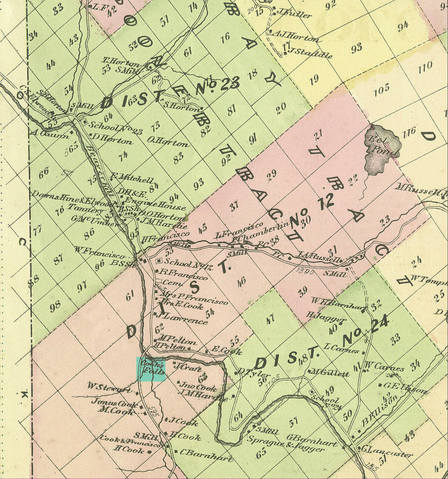 "Took
care of cattle and went down to Cochran's to go to river. Rode one colt to
Falls with E.D. Cochran. Came back and went to Early's with Hiram Hodge
and stayed all night. Thunder shower came up."
"Took
care of cattle and went down to Cochran's to go to river. Rode one colt to
Falls with E.D. Cochran. Came back and went to Early's with Hiram Hodge
and stayed all night. Thunder shower came up."
Joel Kimball
____________________________
____________________________
With the rising water level of the river, Joel took to rafting again,
this time steering for Cochran's mill. His first trip down-river was to
Cook's Falls with Chester Cochran. He left Chester and returned on foot to
Cochran's mill, riding his second colt with Hiram Hodge to the flats below
East Branch. - fred
Tuesday, April 21, 1874
"Started from Early's and walked to Cooks Falls with H. Hodge. Pulled out
a colt and ran to Maynard's about noon. So many rafts came in we could not
lash up.
"Cool, windy and some rain."
Joel Kimball
![]()
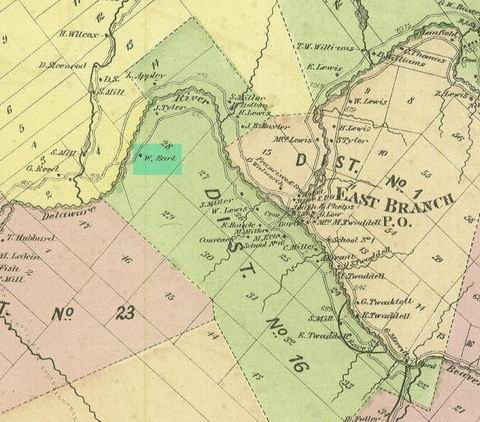 Midway
between East Branch, where the waters of the Beaverkill empties into the
East Branch of the Delaware River, and Fishs Eddy are the long flats that
were once the William Early farm, a stop-over place for upper-Beaverkill
pilots. The farm had some of the finest farm land along the East Branch,
known for producing an abundance of crops. River flood were good for the
soil, constantly adding fresh loamy silts and sands to the fertile fields;
that is unless the flood occurred during the growing season. In the fall
of 1869, these fields were ripe with acres of pumpkins when the swift
water of the Delaware overflowed its banks and picked the vines cleaned,
scattering the pumpkins downriver, this flood forever known as "The
Pumpkin Flood."
Midway
between East Branch, where the waters of the Beaverkill empties into the
East Branch of the Delaware River, and Fishs Eddy are the long flats that
were once the William Early farm, a stop-over place for upper-Beaverkill
pilots. The farm had some of the finest farm land along the East Branch,
known for producing an abundance of crops. River flood were good for the
soil, constantly adding fresh loamy silts and sands to the fertile fields;
that is unless the flood occurred during the growing season. In the fall
of 1869, these fields were ripe with acres of pumpkins when the swift
water of the Delaware overflowed its banks and picked the vines cleaned,
scattering the pumpkins downriver, this flood forever known as "The
Pumpkin Flood."
William Early had just died the previous month, leaving his son Ransel
and his wife Sarah Ann Rose, with the farm. Joel and Hiram walked back to
Cooks Falls that morning to pick up the colt banked there from the day
before. - fred
Wednesday, April 22, 1874
"At Maynard's, commenced to lash colts together and let down. Raft into us
and jammed us up and we went to Partridge Island with three colts. I came
back and ate dinner and ran other colts down and lashed up.
"I paid bill, $1.65.
"Paid for M.P. Bennett, $1.00."
Joel Kimball
 The
river's high water brought what may be the last opportunity of the
spring for lumbermen to send their lumber down-river. The consequences of
so many rafts at once resulted with the river being congested with rafts,
and encounters that added to the lore, and for some the lure, of rafting.
The pile-up of rafts along the Delaware's banks at Maynard's showed the
importance of this lumber river-community, newly formed with the recent
completion of Midland railroad, with Milton Maynard's mill up Fishs' Creek
and the establishment of a new tavern.
The
river's high water brought what may be the last opportunity of the
spring for lumbermen to send their lumber down-river. The consequences of
so many rafts at once resulted with the river being congested with rafts,
and encounters that added to the lore, and for some the lure, of rafting.
The pile-up of rafts along the Delaware's banks at Maynard's showed the
importance of this lumber river-community, newly formed with the recent
completion of Midland railroad, with Milton Maynard's mill up Fishs' Creek
and the establishment of a new tavern.
Partridge Island, a mile and a half below, was the early settlement in
this section. It was the changeover in size of the riverbed at this
location that prompted Joel and his crew to lash their colts together
into the larger raft. It was also the location of the popular Wheeler
tavern which served the thirsty river pilots and their crews for over a
half a century. It also was the location of the first saw mill in the
valley of the East Branch, with a history of producing the finest of pine
timber sent to market down-river. That was until the great pumpkin flood
of 1869, when it was swept away along with the valley's summer crop of
pumpkins. - fred
Thursday, April 23, 1874
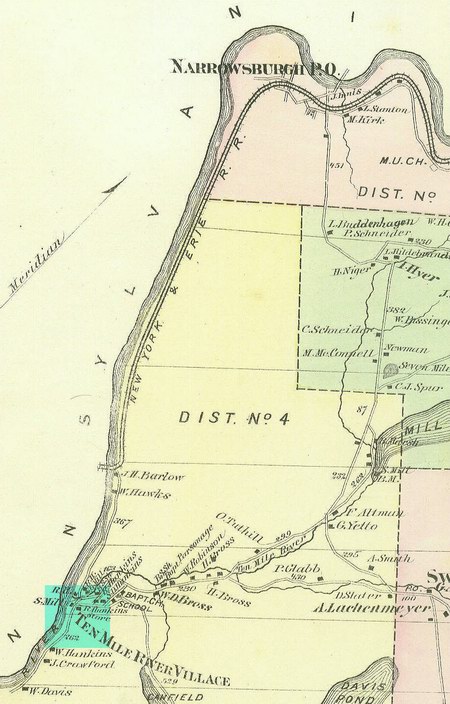 "Cold
and rain and snow.
"Cold
and rain and snow.
"Pulled out and ran to Ten Mile River, landed about six o'clock; dull,
cold, rainy day. Milton Bennett got off to snub at Pops Island and lost
rope and had to run down the road one mile. We pulled in and I let him on,
our crew are H. Hodge, steering; M.P. Bennett, helping; Robert Dougherty
and myself forehands."
Joel Kimball
______________________________
______________________________
The colts lashed together at Partridge Island formed a double raft of
sawed lumber, twenty-five feet wide and seventy-five feet long. Managing
this vessel required a four-man crew to operate the raft's four,
eight-foot oars, two at each end, which were used to guide and steer the
raft through the currents. The men working on this crew were Joel and his
uncle Hiram Hodge, his neighbor Robert Dougherty and Milton Bennett from
Buckeddyville.
Robert Dougherty is the brother of Mary Jane Dougherty Purvis, the wife
of Aaron Purvis, both members of the Dougherty family from Little Ireland.
He would eventually find employment with the railroad and move to
Middletown. His son, Lester, would also find employment with the railroad
and eventually return to his ancestral home in a final, tragic journey.
While riding as fireman upon the locomotive of the Mountain Express during
the early summer of 1909, the engine rode off the rails, dragging itself
and the cars behind it onto the potato patch which was directly across the
river from the old Joel Kimball farm. Lester became pinned underneath the
engine as the escaping steam from the broken pipes scalded him to a
horrible death. The wreck on White House Curve, as this accident was to
become known as, occurred only a couple of miles from his father's old
farm. fred
"Pulled out from Ten Mile River and ran to Schoonmaker's. Stayed at the old hotel, weather cool in morning and warmer and pleasant in the afternoon, time passed quite pleasantly. Had strong pull at Sawmill Rift."
Joel Kimball
![]()
"Come all you jolly raftsmen, who run the river down,
Be careful where you run your raft or you will run aground
And Boys, shove your grog around
The scores are on their own.
For we're the boys who fear no noise
Although we're far from home
Well we sailed around old Butler, and nothing did we fear
Until we came to Sawmill Rift, and plunged against the pier.
Now, Hiram Hodge stood at the oar, his voice so firm and strong
For when he struck the rock, by God, it almost knocked him down.
There was one among our number, and his name was Little Dough
He plunged right in among the logs and saved 'most all our clothes."
Raftsmen Song, author unknown
Perhaps the trickiest section along the Delaware River for rafts to
pilot through were the rocky rifts above Sparrowbush. The scenery may have
been spectacular as the river passed beneath the tall ledges above known as
the Hawk's Nest, but in the swift rapids below, any slight miscalculation on
reading the river's current could be the undoing for both raft and crew. As
the waters of the Mongaup entered into the main river, the rapids of Mongaup
Falls formed a chute between boulders, the tall waves crashing over the bow
of the raft.
There was no respite coming to the steersman for Butler's Falls, immediately
below, threatened the destruction of the raft if it ventured too close to
the cliffs on the New York side of the river. The deep depression roiled the
water into the "Cellar Hole" that, once trapped, put the raft at the
complete mercy of the swirling current.
The falls themselves at Sawmill Rift were not particularly dangerous to the
raft and crew; it was the obstacle placed at the lower end of the rift, the
bridge pier of the Erie Railroad as it crossed the river into Pennsylvania.
The rift was a mile long, lined on either side with submerged boulders,
requiring the raft to hold steady to the center. Any slight deviation from
this course would put the raft into the bridge's pier or onto the boulders
at its foundation.
"Well we sailed around old Butler, and nothing did we fear
Until we came to sawmill Rift, and plunged against the pier."
The ride down Sawmill Rift often had unplanned, exciting results for the
raftsmen. During the April freshet of the previous year, coincidentally on
April 24th, a large raft strayed from the safe passage of the river's center
and smashed onto the rocks, ripping the raft completely in two. One portion
had one man remaining on it with but one oar for steering. For five miles he
maneuvered the craft until he was finally able to land it safely. The second
portion, with the remaining crew, continued one mile farther downstream,
where it wrecked upon the rocks and broke-up into pieces.
Three days before this incident, three large rafts from Sullivan County that
were lashed together, ran aground at Sawmill Rift, one of the rafts breaking
up and its lumber washed downstream and lost. The year of 1873 was noted as
being particularly harsh on Beaverkill lumbermen, sustaining heavy monetary
losses with these and other accidents along the river.
fred
"Pulled out from Schoonmaker's and ran to La Bars, commenced to storm, rain and snow and hail. Wind blew very hard. Stayed all day and had pleasant time, very nice people.
"Ostrander, Cochran and Hiram Borden and W. Darbee came in and stopped there and all stayed together
"Snow fell about two inches."
Joel Kimball
![]()
Joel's raft was now below the Delaware Water Gap when the storm came
up. High winds along the wider, lower Delaware river often created havoc
with rafts, blowing them onto the shore, into bridge piers or stranding them
on sandbars and rocks, causing substantial losses in both time and material.
Knowing the dangers, the crew waited out the storm at Labar's while a second
raft from Cochran's mill at Westfield Flat caught up with them.
George Labar had a long life; by 1874 he was close to one hundred and twelve
years of age, with hardly a day of sickness throughout his many days. During
the Pennsylvania State Fair held at Easton the previous fall, George was one
of the novel side-shows, exhibited in a tent where he would marvel the crowd
with his sharp memory and told stories of times gone by along with
Revolutionary war tales. Sitting next to him was his young daughter, now
well into her eighties, who was in charge of the coins that were dropped
into her father's felt hat. fred
Sunday, April 26, 1874
"Pulled out from La Bars and ran to Sandts, landed because the wind blew
very hard. H. Borden and Wes Darbee landed on the Jersey side. Stayed at
Theodore Sandts.
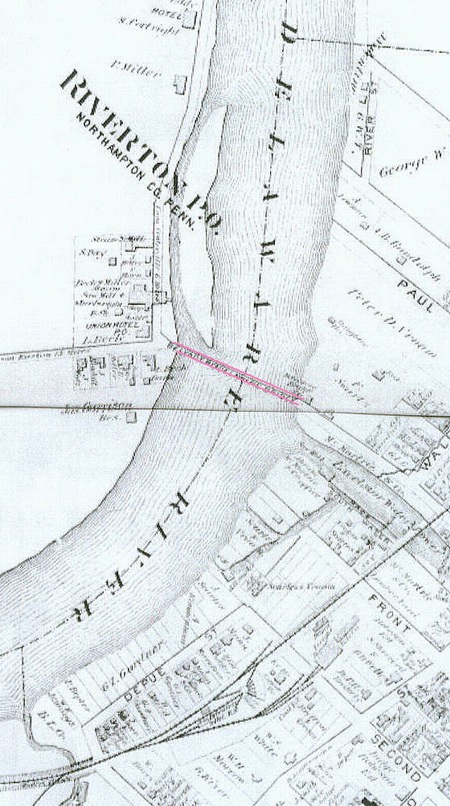 "Had
pretty rough pull at Belvedere Bridge. Raft ran on head of Foul rift
Island ahead of us and we ran partly over them. Quite an exciting time.
"Had
pretty rough pull at Belvedere Bridge. Raft ran on head of Foul rift
Island ahead of us and we ran partly over them. Quite an exciting time.
"Windy and cool."
Joel Kimball
_______________________
The lower Delaware presented new challenges to Joel and his raft-mates;
heavier raft traffic and numerous bridge crossings. The Belvedere-Delaware
covered bridge crossed over the Delaware River from Belvedere, New Jersey
to Riverton, Pennsylvania. Soon after its initial construction, this toll
bridge was partially swept away by high water during an April flood of
1836, but was rebuilt the following year. The bridge was six hundred and
thirty feet in length, the four sections supported by stone piers and
abutments allowing river traffic to pass underneath between the piers. The
trusses of this bridge had an arch pattern incorporated into the structure
where the arches and the truss' plank covering tapered down to each pier
and abutment, further narrowing the passageways. Already sitting low over
the river, high water complicated the safe passage underneath.
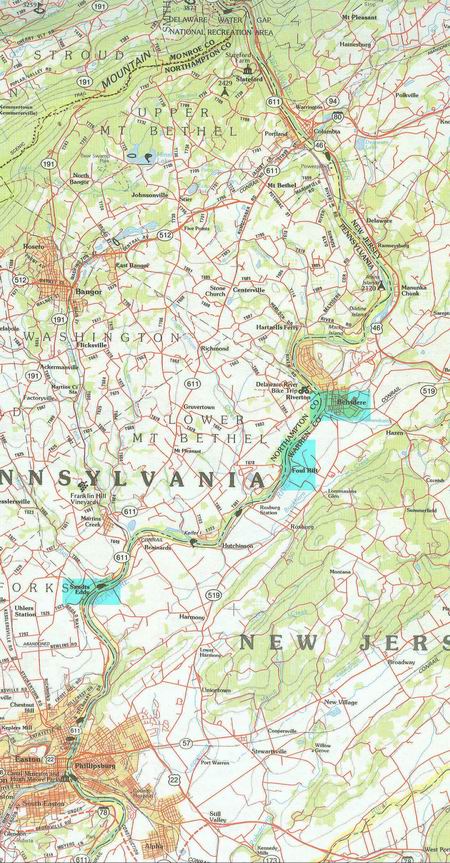 Immediately
downstream from Belvedere was perhaps the most dangerous section along the
Delaware; Foul Rift. With the river at high-water, this three-mile long
rift was composed of rugged stones and ledges on either side of the
channel, which required the raft to stay in the center, which also was
composed of rugged stones and ledges, hopefully submerged enough for the
raft to ride overtop. Foul Rift Island was located on the Jersey side of
the rift, the narrow channel passing close by. The river's rapid current
tended to push the raft in the direction of the rocks and ledges along the
island, while the crew worked hard to keep the raft within the channel. At
the bottom of the rift was a ledge that extended nearly the whole width of
the river. If the raft was lucky enough to make it this far down the rift,
the sudden drop of three feet over the ledge threatened to rip the raft
apart.
Immediately
downstream from Belvedere was perhaps the most dangerous section along the
Delaware; Foul Rift. With the river at high-water, this three-mile long
rift was composed of rugged stones and ledges on either side of the
channel, which required the raft to stay in the center, which also was
composed of rugged stones and ledges, hopefully submerged enough for the
raft to ride overtop. Foul Rift Island was located on the Jersey side of
the rift, the narrow channel passing close by. The river's rapid current
tended to push the raft in the direction of the rocks and ledges along the
island, while the crew worked hard to keep the raft within the channel. At
the bottom of the rift was a ledge that extended nearly the whole width of
the river. If the raft was lucky enough to make it this far down the rift,
the sudden drop of three feet over the ledge threatened to rip the raft
apart.
Once entering the rift, the crew required experience, skill, muscle,
quick-action and a little luck. For the next ten minutes, the time it took
to ride the rift's three miles, the pounding of the submerged rocks on the
raft's under parts, the breaking waves swamping the raft's forward
portions and the deafening roar of the rushing water certainly would be a
"quite exciting time" for Joel.
fred
"Foul Rift, which commences at Belvedere, is the spot most dreaded by raftsmen. It is a narrow rapid, three miles long, flowing between high, ragged, rocky shores and carrying a raft through in less than five minutes. Pilots, in entering Foul Rift, steer by a tree on the Pennsylvania side of the river. The raft must be headed at just a certain angle, or it is sure to be dashed to pieces. The raft, one safely in the channel, each man seizes tightly hold of his oar, which is raised clear of the water, and does nothing but look out for his own safety. The water covers the raft completely, and it is with great difficulty that a foothold is maintained. Numberless rafts have been dashed to pieces at this spot, and many lives lost in the seething waters of "Foul Rift.""
May 11, 1872
New York Times
"Landed in Trenton all right about half past six, ate supper and went to New York. Pulled out of Sandts about half past five, passed Easton safely.
"Saw Phil Sheeley on the bridge who told us Jeffry Campbell was drowned in the Beaverkill, don't believe it.
"Hiram Hodge due for one trip down river, $25.00
for cash, paid expense, $1.25
credit by cash, $15.00"
Joel Kimball
![]()
After yesterday's ride through Foul Rift, Joel's crew pulled the raft
ashore at Sandt's Eddy outside of Easton and bedded down at the hotel there.
The eddy was over two miles long, allowing the lumber rafters to pause and
relax with the hotel's accommodations for a spell, or in some cases,
gather-up the remains of their raft now floating in pieces lazily in the
calmer waters.
The Eagle Hotel was long a favorite stop-over for rivermen. The old stone,
family run hotel was now under the proprietorship of Theodore Sandt, who
also was the dealer in general merchandise in this small riverside
community. By 1874, about a dozen dwellings lined along the river, most of
them owned by the Sandt family members. During the busy lumber-rafting
season, two to three hundred guests would lodge at any given time at Sandt's
Eddy, those not staying at the Eagle Hotel would find accommodations amongst
the other Sandt families, or in many cases, sleeping on boards in
outbuildings, or outside. - fred
"Stayed at home made hotel, ate breakfast. I went to depot and found we could start for home nine o'clock.
"Called at Casey and Neves and Thomas Bates mill, Number 7 Warren Street and a place on Chamber Street, Geo. Crippen with me.
"Started on Erie road for Middletown, arrived all right, then took Midland road to Morsston, arrived half past two and came home."
Joel Kimball
![]()
Just as Joel had thought, yesterday's reported demise of Jefferson Campbell was a bit premature, by about forty-two years. The young twenty-year-old friend of Joel's worked on the river, as so many other young men during this era, along with being a carpenter. Jefferson would later become a dealer in general merchandise, being a partner of a business concern in the growing community of Roscoe. His most noted achievement, though, was the building of a hotel on the hill overlooking Roscoe. The Campbell Inn was the first of the large summer boarding houses in this area and, to some limited extent, is still in operation today. - fred
"Stormy day.
"Went on the hill and delivered hay to Col. Moore at $12 per ton, drew a small load home, ate dinner at Moore's.
"Snow and blew all day. Two new milch cows today."
Joel Kimball
![]()
Back home from his adventure down the Delaware, Joel is back to tending to the family farm. Spring is calving season and it appears that two of his young heifers gave birth while he was away, adding to his herd and producing two more milk-cows. - fred
"Wind blowing very hard.
"Went on the hill and split rails. After noon went up to depot and got eight bushel oats at 75c per bushel.
"Copied mortgage for J.T. Sherwood. Lost one bag oats by bag becoming untied. Mother went to Uncle Oliver Borden's.
"Received letter from L."
Joel Kimball
![]()
Barbed wire, strands of woven wire with short twists of sharply
pointed wire interspaced within the strands, has just recently been patented
and beginning to make an impact between farming and ranching methods and the
coming range wars in the west, but has yet to have much effect on the small
farms back east. Joel still used what natural resources he could find on his
own farm to use as material for fencing; rocks for stone walls or timber for
rail fences
The lumber that Joel has been cutting from "the hill" is from a fifty acre
lot behind his parents smaller farm lot down by the river. The lot has now
been cleared enough to harbor his few cattle and steers, with the less
marketable timber being cut and split into lengths to be used for split-rail
fencing. - fred
